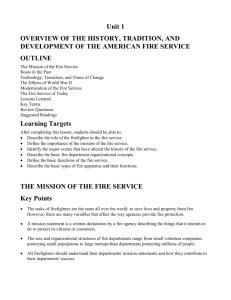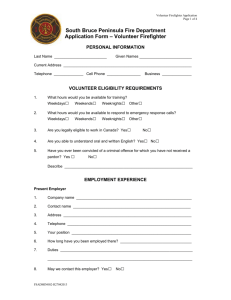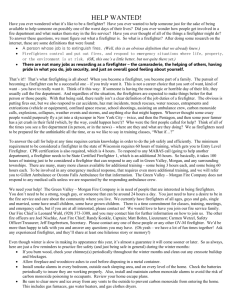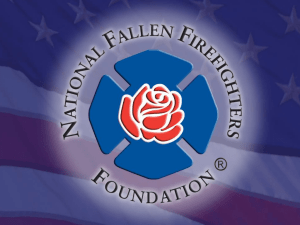Untitled Web Page - District 1 Fire Academy
advertisement
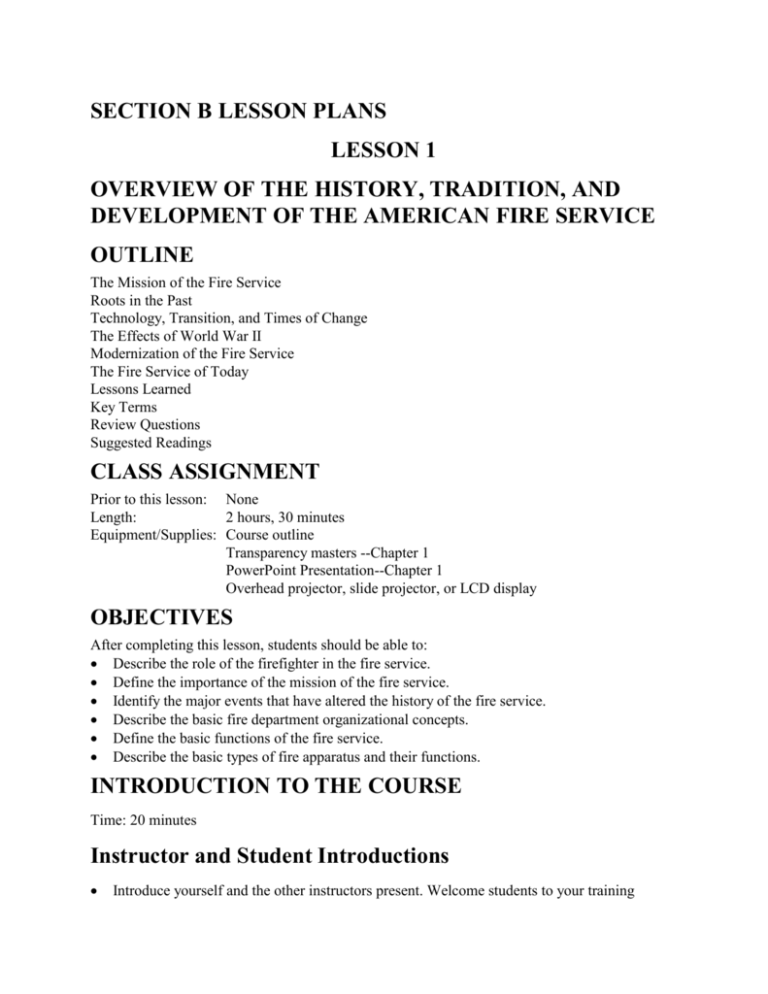
SECTION B LESSON PLANS LESSON 1 OVERVIEW OF THE HISTORY, TRADITION, AND DEVELOPMENT OF THE AMERICAN FIRE SERVICE OUTLINE The Mission of the Fire Service Roots in the Past Technology, Transition, and Times of Change The Effects of World War II Modernization of the Fire Service The Fire Service of Today Lessons Learned Key Terms Review Questions Suggested Readings CLASS ASSIGNMENT Prior to this lesson: None Length: 2 hours, 30 minutes Equipment/Supplies: Course outline Transparency masters --Chapter 1 PowerPoint Presentation--Chapter 1 Overhead projector, slide projector, or LCD display OBJECTIVES After completing this lesson, students should be able to: Describe the role of the firefighter in the fire service. Define the importance of the mission of the fire service. Identify the major events that have altered the history of the fire service. Describe the basic fire department organizational concepts. Define the basic functions of the fire service. Describe the basic types of fire apparatus and their functions. INTRODUCTION TO THE COURSE Time: 20 minutes Instructor and Student Introductions Introduce yourself and the other instructors present. Welcome students to your training facility and to the firefighter course you are teaching. Have students introduce themselves by sharing their names, their affiliations, and any experience that they may have had in firefighting. Give a brief description of your background and credentials. Allow the other instructors to do the same. Orientation to the Location Point out the locations of the restrooms, telephones, fire exits, break facilities, and explain any building rules and regulations students should be expected to know. Ask students to wear comfortable clothing that will enable them to participate in activities. Explain to students that they are responsible for providing their own personal protective equipment. Provide a list of all required supplies and equipment. Course Schedule Distribute a course schedule that includes dates and times of class meetings, lesson contents, and class assignments. Skill-practice sessions and examinations dates and times should be clearly identified. Indicate dates that students will have to bring any special equipment. Course Description Describe to students the purpose of this course. Explain to them that this course meets the NFPA Standard 1001, which addresses what has to be taught in a firefighter class. If you are teaching Firefighter I and II, describe the differences. Textbook Identify the textbook for this course, Firefighters' Handbook, and lead the students through it. The textbook for this course is required reading. Instruct the students on how best to use the textbook to master the course content. Instructors may also wish to introduce and briefly review the student workbook if it is being used. Course Completion Requirements Describe the requirements for completing the course. These requirements may be determined by your state or local jurisdiction. To successfully complete this course, the student must: Correctly demonstrate the skills taught in the course. Correctly answer at least 70 percent of the final written exam questions. Instructor's note: If there are academic or local agency requirements beyond the minimum course completion requirements, explain them to the students at this time. THE MISSION OF THE FIRE SERVICE Firefighter's Handbook, page 4 Time: 15 minutes Key Points The tasks of firefighters are the same all over the world: to save lives and property from fire. However, there are many variables that affect the way agencies provide fire protection. A mission statement is a written declaration by a fire agency describing the things that it intends to do to protect its citizens or customers. The size and organizational structures of fire departments range from small volunteer companies protecting small populations to large metropolitan departments protecting millions of people. All firefighters should understand their departments' mission statements and how they contribute to their departments' success. ROOTS IN THE PAST Firefighter's Handbook, pages 4-16 Time: 45 minutes Key Points Firefighting has always been a courageous act, as the fire problem has passed from those obscure ancient events to the stresses of modern fires of various types and sizes. While the fire service contains a great deal of tradition, it is important to recognize that the task of being a firefighter is an old, yet constantly evolving occupation. The job of being a firefighter today is very much different than it was in the past. Regardless, every thing a fire agency does to protect its citizens is rooted in events from the past. For the last 350 years, the fire service in this country has advanced on all fronts. In the last few decades, the working environment of firefighters has dramatically changed. Ancient Beliefs Beliefs about fire can be traced back to ancient Greek mythology. The Greeks considered fire a force of nature that was to be feared. Recorded History Recorded Roman history indicates the Romans worshipped a fire goddess, Vesta. The first record of an organized fire department goes back to the Roman Empire when the Romans were trying to protect their capital city. In a.d. 6, the first permanent fire brigade, called the "Cohort¯es Vigilum," was established. They were housed in a large barracks and were tasked with touring the streets at night looking for fires. Under the Emperor Augustus, military units under the command of a tribune reported to an officer of equestrian rank, a prefect. There were men that worked pumps directing fire streams and men with grappling hooks to tear off roofs and tear down walls. Even with the formation of these brigades, Rome burned down many more times. Roman leaders attempted to use fire regulations to control the use of fire. After the collapse of the Roman Empire, Europe did not see any dedicated fire forces for more than 1,000 years. Early History and Symbols of the Fire Service During the time of the Crusades, bands of knights going to the Holy Land were organized into orders. The Order of Saint John of the Hospitaliers dedicated themselves to the treatment of serious wounds caused on the battlegrounds. During the same time period the Order of the Knights of Malta was formed. The knights were trained to save others. They served as stretcher-bearers for victims of battle. After battles they carried victims back to the hospitals. Symbols used on the knights' uniforms and shields identified them as trained to protect and not to kill. The symbol for the Order of Saint John was a red cross, and the symbol for the Knights of Malta was the Maltese cross. Today these symbols are still used in fire and emergency services. The Middle Ages From the fall of the Roman Empire to the beginning of the Middle Ages, there are many accounts of the devastation of major European cities through fire. Over a period of 500 years, the English devised a whole set of fire regulations. Despite the fact that the punishment for arson was to be burned alive, arson remained a serious crime. Even though there was a big push for prevention, fire continued to cause devastation. In 1666, London burned down. Originally called the Pudding Lane fire, it was later called the Great Fire of London. The next 200 years would see the creation of almost all of the basic institutions that provide fire protection today. This included the creation of an organized fire department, creation of a fire insurance industry, and an increase in technology to prevent and fight fires. Early American History When settlers came to America they brought with them practices from their European countries of origin. Some of the very first laws established in the New World dealt with fire prevention. In 1637, the King of England authorized the firm of Ryley and Mabb to create "insurance." This was a very unique idea that did not receive much attention until the Great Fire of London. Signs on sheets of metal marked occupancies that were insured and indicated which company held the insurance. These sheets were called firemarks and were also used by the early settlers in America. Fire suppression capabilities were a priority. In 1647, the city of Boston sent an order to London for a pumper. Unfortunately, it did not arrive in time for the fire in 1653 that almost destroyed the town, and that fire had to be fought with bucket brigades. In the early 1700s, fire wardens were designated in Boston. They carried wooden rattles that they would make noise with if they found a fire. These people were labeled the Rattlewatch. In 1718, the fire wardens created fire societies. The societies were made up of groups of people who worked together to deal with their communities' fire problems. This would be the beginning of the era of the volunteer firefighters. In 1736, Benjamin Franklin was the co-founder of the Union Fire Company. Benjamin Franklin is considered by many to be America's first fire chief. Many other leaders, such as George Washington, Thomas Jefferson, John Hancock, Samuel Adams, and other key figures were involved in the creation of fire companies and the acquisition of fire suppression equipment from Europe. In 1752, Benjamin Franklin started his own insurance company, The Philadelphia Contributorship. Using one of many European ideas, firemarks were used to let suppression crews know that the contents were insured. These metal signs were made from lead and were attached to the buildings that had insurance. While many fire insurance companies are still active, many of the firemarks were removed from houses during the Revolutionary War and the War of 1812 to make lead bullets. After the Revolutionary War, almost all of the equipment that had been used was either destroyed or badly damaged. The American fire service began to evolve away from European customs and styles. Fire companies began to grow. By the 1800s, most settlements had a volunteer fire company, and most even had some form of pumping apparatus powered by volunteers. There were volunteer fire companies for just about every ethnic and political orientation in society. Many of the young men who had returned from the war became part of the fire companies. A leather hat maker named Andrew Gratacap developed the American fire helmet. Originally it was designed like a top hat with the name of the fire company. Later the idea of short front brims and an extended back brim was incorporated into the design. Firefighters also copied the large front piece off the Hessian soldier helmet to create the distinguished American fire helmet profile. Most Europeans use a military type helmet. The American fire helmet began to be a symbol of the departure from the past. One event that significantly affected the fire service was a riot by volunteer firefighters at a fire in Cincinnati, Ohio, in the 1850s. City leaders were so distressed at the behavior of these volunteers that they instituted the first full-time paid firefighting force in 1853. As cities continued to grow, city after city began to realize that fire protection required a fire department with full-time, paid firefighters. Paid forces were not universal. Many communities chose to retain their volunteer firefighters. Today, the volunteer fire force still constitutes more than half of the fire service in the United States. The Civil War The Civil War played a great role in the history of the American fire service. The Civil War did not provide any specific advances in firefighting technology, since thousands of volunteer firefighters volunteered for the war. Many were killed or returned injured and could no longer serve. After the war, hundreds of veterans returned looking for jobs and ways to help the community. Those cities that had converted to paid personnel saw these army veterans as excellent choices. One of the most recognizable symbols of fire departments was also established at this time. The Dalmatian was designed to be a companion for horses, to calm them and chase away small animals. The end of the war created a new wave of professionalism. Insignias and ranks began to be used in the fire service. In 1873, the fire chiefs, who were often called fire engineers, united to create the National Association of Fire Engineers. Today, it is known as the International Association of Fire Chiefs. Despite all efforts, fires such as the Great Chicago Fire and the Pettifog Forest Fire (1871) continued to devastate large cities during this era. The Industrial Revolution The turn of the century brought about the Industrial Revolution in the United States. A primarily farming society was turning into a leader in industry and commerce. A young man named Henry Parolee invented a device called the automatic sprinkler system. As these systems were installed, the number of losses to fire began to diminish. Individuals involved in designing and installing automatic sprinklers formed a new organization called the National Fire Protection Agency (NFPA). The group took the task of forming this new concept into a standard, which was given the number one. It was the first, but certainly not the last, national fire code of the United States. The first fire alarm system was created in the 1870s. Most of the information on fire hydraulics was gathered during this time. The first aerial apparatus was designed by San Francisco firefighter Daniel Hayes. The Turn of the 20th Century The turn of the century not only showed great advances in technology, it created greater challenges for firefighters. There were changes in how things were done and changes in firefighter working conditions. Together firefighters formed a labor union, the International Association of Fire Fighters. A series of large losses of life due to fire during the era put the subject of fire prevention at the forefront of the fire service. Almost all of the advances in fire prevention that have created the fire and building codes we know today were created during this time period. In the 1920s, Fire Chief Ralph Scott of the Los Angeles Fire Department expressed a concern about the quality and quantity of fire service training. He created an educational committee to look at the training of firefighters. Most departments had training programs in place, but there was no organized, systematic listing of tasks, skills, and knowledge based on current practices and needs in the fire service. In 1931, a document called Fire Fighting Bulletin Number 155, series 44, Federal Board of Vocational Education was produced by this project. This was the landmark document upon which all subsequent fire service training and education has been based. It created the minimum standards for the training of entry-level fire personnel. TECHNOLOGY, TRANSITION, AND TIMES OF CHANGE Firefighter's Handbook, pages 16-17 Time: 15 minutes Key Points The internal combustion engine made it possible to make one fire apparatus out of three. The same vehicle could carry water, a pump, and the amount of hose and equipment needed to apply the water. A review of apparatus designs from the turn of the century to the present will demonstrate that the fire service tends to adopt any technological improvement as soon as it has proven its dependability. THE EFFECTS OF WORLD WAR II Firefighter's Handbook, page 17 Time: 15 minutes Key Points While the war took away many firefighters, it did provide some benefits. Several military projects were used during the war that furthered the firefighting cause. One such project was research that resulted in the development of the indirect attack method. After the war, two important books were written: Firefighting Tactics and Strategy and Attacking and Extinguishing Interior Fires. Research into fighting flammable liquid fires resulted in improved foams for use by the fire service. Personal protective equipment technology and nozzle technologies were improved. From the 1950s to the 1990s, the fire service saw more changes than in the previous 200 years. Many innovations continued to emerge. The use of radios for fire engines improved communications, and the introduction of the diesel engine improved road performance. Additional duties emerged in the fire service, including EMS services, hazardous materials response, and search and rescue. MODERNIZATION OF THE FIRE SERVICE Firefighter's Handbook, pages 17-18 Time: 15 minutes Key Points The modernization of the fire service is a process, not a place in time. What has not changed has been the basic mission of the firefighter. All firefighters entering the fire service should be aware of two concepts: information halflife and technological obsolescence. Information half-life is how long it takes for 50 percent of the information you have to be obsolete or inaccurate. Technological obsolescence means that any given technology will only be useful for a certain period of time before another replaces it. THE FIRE SERVICE OF TODAY Firefighter's Handbook, pages 18-19 Time: 15 minutes It is estimated that there are 33,000 fire departments in the United States. Many are still volunteer systems. In 1970, the National Commission on Fire Protection and Control published a document called America Burning. This led to the creation of the United States Fire Administration and the development of the National Fire Academy. The fire service of today is a very diverse, complicated system of delivery. Regardless, the fire service of today contains a great deal of the past. We have become what we are today based on our past experiences. The basic mission of saving lives and property has not changed, only the manner and means to cope with the problem. WRAP-UP Time: 10 minutes Key Points The role of the firefighter in the fire service has evolved from the Roman Empire to the firefighters of today. The mission of the fire service has been around since the beginning of fire: protect life and property. Through the ages this mission has been kept, but our approach to it has changed. The evolution of the fire service in the United States has grown together with our nation. From the days of human-powered pumpers to the days of modern pumpers, equipment has evolved to help firefighters do their jobs. As long as fire is able to kill and destroy, there will be a fire service to save and protect life and property. Assignment Read Chapter 2 in Firefighter's Handbook. Complete Firefighter's Handbook Workbook Chapter 2 (optional). Instructor Preparation PowerPoint Presentation-Chapter 2 Transparency masters-Chapter 2 Sample rules and regulations ICS kits


